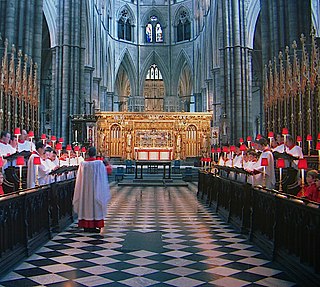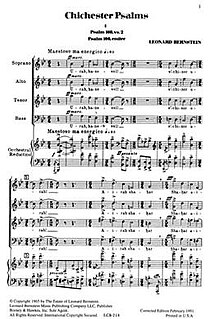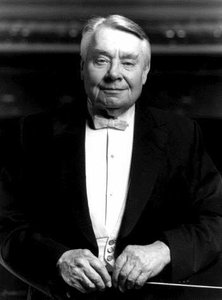
Music notation or musical notation is any system used to visually represent aurally perceived music played with instruments or sung by the human voice through the use of written, printed, or otherwise-produced symbols.
The time signature is a notational convention used in Western musical notation to specify how many beats (pulses) are contained in each measure (bar), and which note value is equivalent to a beat.
In music, solfège or solfeggio, also called sol-fa, solfa, solfeo, among many names, is a music education method used to teach aural skills, pitch and sight-reading of Western music. Solfège is a form of solmization, and though the two terms are sometimes used interchangeably, the systems used in other music cultures such as swara, durar mufaṣṣalāt and Jianpu are discussed in their respective articles.

Polyrhythm is the simultaneous use of two or more conflicting rhythms, that are not readily perceived as deriving from one another, or as simple manifestations of the same meter. The rhythmic conflict may be the basis of an entire piece of music (cross-rhythm), or a momentary disruption. Polyrhythms can be distinguished from irrational rhythms, which can occur within the context of a single part; polyrhythms require at least two rhythms to be played concurrently, one of which is typically an irrational rhythm.

Gregorian chant is the central tradition of Western plainchant, a form of monophonic, unaccompanied sacred song of the Roman Catholic Church. Gregorian chant developed mainly in western and central Europe during the 9th and 10th centuries, with later additions and redactions. Although popular legend credits Pope Gregory I with inventing Gregorian chant, scholars believe that it arose from a later Carolingian synthesis of Roman chant and Gallican chant.
This is a list of musical terms that are likely to be encountered in printed scores, music reviews, and program notes. Most of the terms are Italian, in accordance with the Italian origins of many European musical conventions. Sometimes, the special musical meanings of these phrases differ from the original or current Italian meanings. Most of the other terms are taken from French and German, indicated by "Fr." and "Ger.", respectively.
In music, a tuplet is "any rhythm that involves dividing the beat into a different number of equal subdivisions from that usually permitted by the time-signature ". This is indicated by a number, indicating the fraction involved. The notes involved are also often grouped with a bracket or a slur.
A strathspey is a type of dance tune in 4
4 time. It is, simply stated, a reel played at a slightly slower tempo, with slightly more emphasis on certain beats. This emphasis can be the same measure to measure or vary throughout the tune, depending on the player. Cut-dot snap rhythms, or "Scotch snaps", are a feature of both. These are short notes before a dotted notes, which in traditional playing is generally exaggerated rhythmically for musical expression. An example of a strathspey would be the song "The Bonnie Banks o' Loch Lomond", provided it is sung staccato:

Anglican chant, also known as English chant, is a way to sing unmetrical texts, including psalms and canticles from the Bible, by matching the natural speech-rhythm of the words to the notes of a simple harmonized melody. This distinctive type of chant is a significant element of Anglican church music.

Chichester Psalms is an extended choral composition in three movements by Leonard Bernstein for boy treble or countertenor, choir and orchestra. The text was arranged by the composer from the Book of Psalms in the original Hebrew. Part 1 uses Psalms 100 and 108, Part 2 uses 2 and 23, and Part 3 uses 131 and 133. Bernstein scored the work for a reduced orchestra, but also made a version for a smaller ensemble of organ, one harp, and percussion.

A rehearsal is an activity in the performing arts that occurs as preparation for a performance in music, theatre, dance and related arts, such as opera, musical theatre and film production. It is undertaken as a form of practising, to ensure that all details of the subsequent performance are adequately prepared and coordinated. The term "rehearsal" typically refers to ensemble activities undertaken by a group of people. For example, when a musician is preparing a piano concerto in their music studio, this is called "practicing", but when they practice the concerto with an orchestra, this is called a "rehearsal". The music rehearsal takes place in a music rehearsal space.

In popular music, half-time is a type of meter and tempo that alters the rhythmic feel by essentially doubling the tempo resolution or metric division/level in comparison to common-time. Thus 4
4 approximates 8
8. It is not to be confused with alla breve or odd time. Though notes usually get the same value relative to the tempo, the way the beats are divided is altered. While much music typically has a backbeat on quarter note (crotchet) beats two and four, half time would increase the interval between backbeats to double, thus making it hit on beats three and seven, or the third beat of each measure :
1 2 3 4 1 2 3 4 1 2 3 4 5 6 7 8 1 2 3 4

Te Deum is a setting of the Latin Te Deum text, also known as the Ambrosian Hymn attributed to Saints Ambrose, Augustine, and Hilary, by Estonian-born composer Arvo Pärt, commissioned by the Westdeutscher Rundfunk in Cologne, Germany, in 1984. Dedicated to the late Alfred Schlee of Universal Edition, the WDR Broadcast Choir premiered the Te Deum under the direction of conductor Dennis Russell Davies on January 19, 1985. The Te Deum plays an important role in the services of many Christian denominations, including the Paraklesis (Moleben) of Thanksgiving in the Eastern Orthodox Church. Because of the unusual instrumentation Pärt employs, his Te Deum is not suited for use within the Orthodox Church. It was recorded on the ECM New Series label in 1993 by the Estonian Philharmonic Chamber Choir and Tallinn Chamber Orchestra under the direction of Tõnu Kaljuste. The piece is approximately thirty minutes long.
In music, counting is a system of regularly occurring sounds that serve to assist with the performance or audition of music by allowing the easy identification of the beat. Commonly, this involves verbally counting the beats in each measure as they occur. In addition to helping to normalize the time taken up by each beat, counting allows easier identification of the beats that are stressed. Counting is most commonly used with rhythm and form and often involves subdivision.

Carnatic music terms are briefly described in this page. Major terms have their own separate article pages, while minor terms are defined / described here. Most of the keerthanas/kritis used in Carnatic music is based on Telugu language.

Vocal harmony is a style of vocal music in which a consonant note or notes are simultaneously sung as a main melody in a predominantly homophonic texture. Vocal harmonies are used in many subgenres of European art music, including Classical choral music and opera and in the popular styles from many Western cultures ranging from folk songs and musical theater pieces to rock ballads. In the simplest style of vocal harmony, the main vocal melody is supported by a single backup vocal line, either at a pitch which is above or below the main vocal line, often in thirds or sixths which fit in with the chord progression used in the song. In more complex vocal harmony arrangements, different backup singers may sing two or even three other notes at the same time as each of the main melody notes, mostly with consonant, pleasing-sounding thirds, sixths, and fifths.
Gelineau psalmody is a method of singing the Psalms that was developed in France by Catholic Jesuit priest Joseph Gelineau around 1953, with English translations appearing some ten years later. Its chief distinctives are:
October is a contemporary piece for concert band that was written by Eric Whitacre in 2000. Based on the guidelines as established by the authors of Teaching Music through Performance in Band, October is a Grade 5 piece.

The Missa Brevis by Leonard Bernstein is a musical setting of parts of the mass ordinary in Latin for a mixed a cappella choir with countertenor solo and percussion. It is also Bernstein's last complete choral work, due to his death a year after its completion in 1989.
Anthracite Fields is an oratorio for choir and chamber ensemble by the American composer Julia Wolfe. The work was commissioned by the Mendelssohn Club with contributions from New Music USA and was premiered by Bang on a Can All Stars and the Mendelssohn Club Chorus in Philadelphia, April 26, 2014. It was awarded the 2015 Pulitzer Prize for Music.














